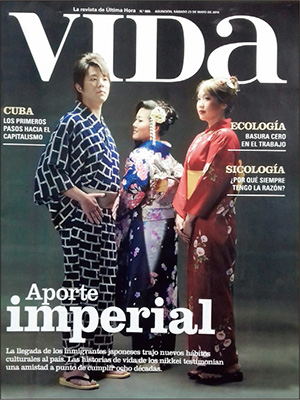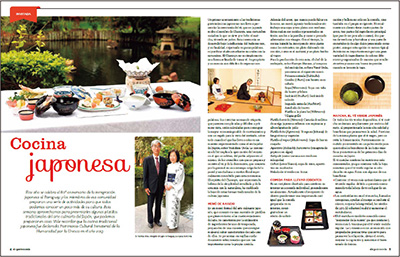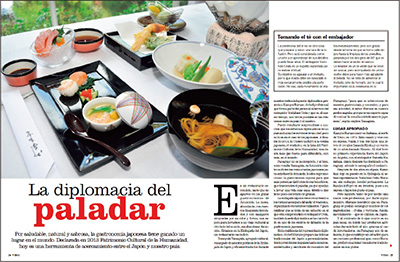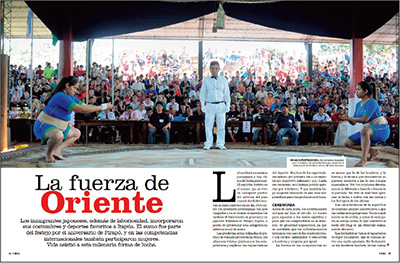Diplomatic Bluebook 2016
Chapter 4
Japan’s Diplomacy Open to the Public
3.Cooperation with Emigrants and Japanese Descendants, Nikkei
The migration of Japanese nationals overseas has a history of 147 years as of 2015. There are estimated 3.60 million overseas Japanese, Nikkei, with especially large numbers residing in the North, Central and South America. They make positive and great contributions to the development of the countries in various fields, including politics, economy, academics and culture, and at the same time, they act as a bridge between Japan and these countries in developing close relations.
Together with the Japan International Cooperation Agency (JICA), MOFA provides cooperation in Central and South America where estimated 2.13 million Japanese descendants live. Various forms of assistance are offered, including welfare support for aging emigrants, training in Japan for Japanese descendants, and dispatch of volunteers to the local Nikkei communities.
Various invitation programs for Nikkei leaders in various fields have been carried out in North, Central and South America. Efforts are underway to strengthen relations with Japanese descendants in these regions. Such efforts include holding conferences between Nikkei leaders and the heads of diplomatic missions overseas to discuss how to enhance bilateral relations and active provision of opportunities for Japanese high-level officials on visits to meet Japanese descendants.
The 56th Convention of Nikkei and Japanese Abroad was successfully held by the Association of Nikkei and Japanese Abroad in Tokyo in October, participated in by about 180 emigrants and their descendants from 17 countries/regions. The welcome party was attended by Her Imperial Highness Princess Takamado, and as for MOFA, Foreign Minister Kishida held a welcome reception to deepen exchange with emigrants and their descendants.
Japan intends to provide support for Japanese emigrants and their descendants, promote cooperation with the young generation and strengthen the bond between these people and Japan.
 Photo 1: UH paper May issue “Gift from the Empire”
Photo 1: UH paper May issue “Gift from the Empire”The Republic of Paraguay located in South America is a landlocked country, not blessed with major natural resources, tourism resources or a consumer market. The country is not well known to the Japanese people because it takes more than 30 hours to fly there from Japan, but the country consists of vast plains and hills blessed with rich rivers and greens where an open and peaceful atmosphere drifts brightly. What visitors to this country feel is that, in spite of the country being located the farthest from Japan on the other side of the earth, the presence of Japan is larger than imagined. This is because Japanese immigrants have greatly contributed to the country’s economic development in agriculture and other various fields. Besides, a variety of tangible and intangible assets of official assistance by Japan have accumulated everywhere in Paraguay. Japanese emigration to Paraguay that began in 1936 marks its 80th anniversary in 2016.
Japanese immigrants developed a settler-oriented land from nothing, which previously had been covered with forest. They cultivated soybeans, vegetables and fruits, and have ultimately developed agriculture to a main industry in this country, where no industry other than animal husbandry existed previously. The efforts must have been extraordinary. The Japanese immigrants who transformed the unpopulated forest into nice farms and towns in this short period have earned the trust and respect of the local society for their sincerity, diligence and perseverance. Now Japanese immigrants and descendents living in urban areas play an active role in various fields as important members of Paraguay society, while they maintain their community, language and culture as Japanese without any contradiction. The trust and respect for the Japanese in local communities as well as the bicultural nature as mentioned above creates a unique presence of a Japanese society.
 Photo 2: ABC paper July issue “Japanese cuisine”
Photo 2: ABC paper July issue “Japanese cuisine” Photo 3: UH paper July issue “Diplomacy of taste”
Photo 3: UH paper July issue “Diplomacy of taste” Photo 4: UH paper August issue “The Oriental force”
Photo 4: UH paper August issue “The Oriental force”In 2015, two major newspapers of this country issued a supplement one after another, in which there were carried special features describing remarkable activities of Japanese descendents. The special features consisted of articles of several pages long each, with focus on the following subjects: People “History of immigrants’ 80-year development” (Photo 1), Culture “The tea room and Japanese food at Japanese Ambassador’s official residence” (Photo 2: Cover photograph shows the Japanese Ambassador and his wife in the Japanese garden and tea house within the compound of the official residence), “The charm of kaiseki cuisine” (Photo 3), and Sports “South America Sumo Championships commemorating the 55th anniversary of Japanese Immigration to Pirapo, Paraguay” (Photo 4). The articles recognized again the locus of Japanese immigrants, and the values and culture they had brought to this country.
What can be read from these articles is the respect for Japanese immigrants in Paraguay society, and a great deal of interest in Japanese culture from traditional aspects, such as tea ceremony to youth culture including manga (comics) and animation. I feel this country is “another Japan on the other side of the earth” embracing a unique sense of intimacy, which you cannot express just as a pro-Japan country.
Detailed information about the articles is available in the Japanese Embassy in Paraguay’s HP “Paraguay news (only in Japanese).” You will see how a total of less than 10,000 Japanese immigrants and their descendants are recognized and how they demonstrate their presence in this country, despite their small population in both absolute and relative terms.

